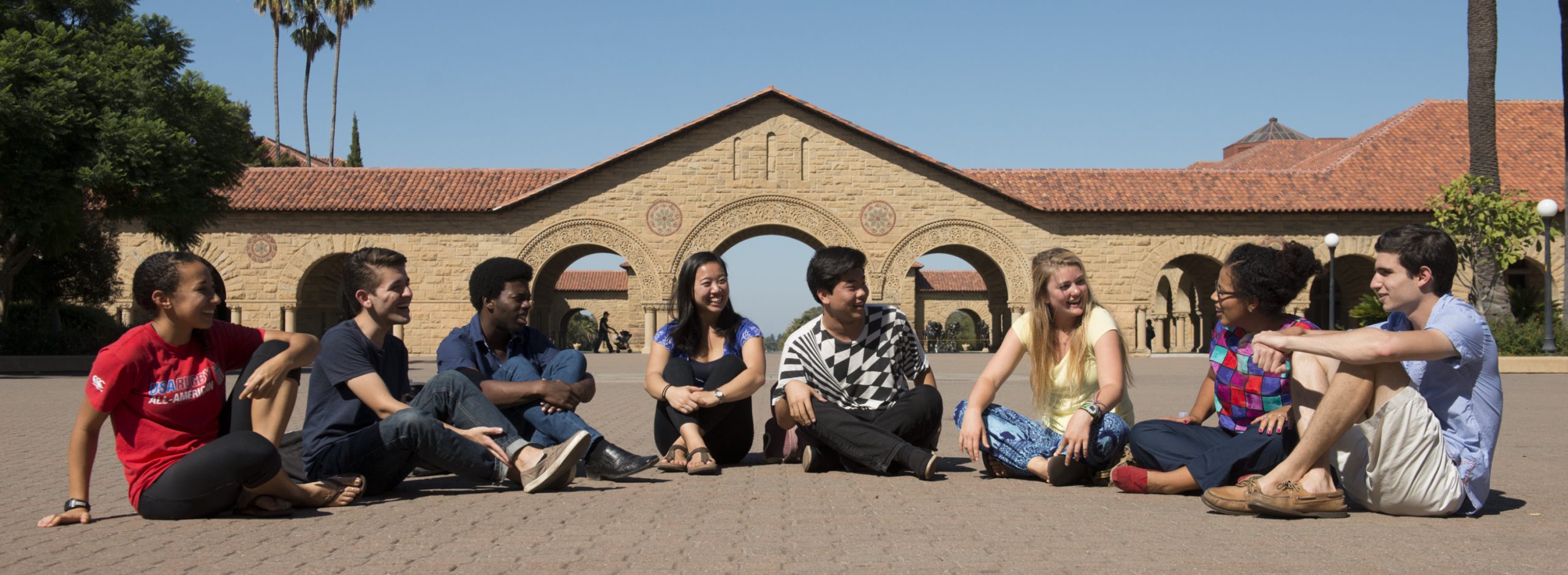Get Admitted to your Dream University – Stanford

Stanford, also called the Ivy of the West, is among the most selective institutions of higher education in the U.S. and the world.
Where is Stanford University situated?
Located 35 miles south of San Francisco and 20 miles north of San Jose, it is in the heart of Northern California’s dynamic “Silicon Valley,” home to Yahoo, Google, Hewlett-Packard, and many other cutting-edge companies that were founded by Stanford alumni.
It is regularly ranked as the most selective because of the number of applicants and the percentage that are accepted. For the class of 2022, Stanford received 47,451 undergraduate applications and accepted 2,071. Out of those, 1,706 students matriculated at the university. This means that the admission rate for Stanford for the class of 2022 was just 4.4%. Many factors draw college-bound high schoolers to Stanford, including its world-class education, gorgeous campus, and athletic excellence—not to mention numerous illustrious alumni, including tech entrepreneurs, Supreme Court Justices, famous actors, notable authors, astronauts, inventors, and even a U.S. President.
Stanford University considers the following “very important” factors in admission decisions:
- Course rigor
- Class rank
- GPA
- Test scores
- Essay
- Recommendation letters
The following additional factors are “considered”:
- Interview
- First-generation student
- Alumni/ae relation
- Geographic residence
- Racial/ethnic status
- Volunteer work
- Work experience
How to Improve Your Chances of Getting into Stanford University
- Achieve a 3.85 GPA while also taking the most challenging classes available.
Stanford considers GPA, class rank, and the rigor of coursework “very important” when making admissions decisions. It’s extremely important for Stanford applicants to not only possess outstanding grades but for those grades to come in challenging courses. Students accepted to a top 10 school like Stanford typically complete between 8 to 12 advanced courses in high school. Advanced Placement or AP exams are conducted by the College Board (same global body that conducts SAT) every year in a wide variety of college-level subjects ranging from Calculus and Computer Science to Art History and English Composition. The main aim of AP exams is to test your ability and acumen to measure up to the rigors of undergraduate curriculum in US and other global universities. Typically, international students appear for AP exams at the beginning of their grade 12. Students interested in Engineering usually appear for Calculus, Physics, Computer Science or Chemistry. Students interested in Business Studies usually appear for Calculus, Microeconomics, Macroeconomics and Statistics.Students interested in Medicine usually appear for Biology, Psychology, Chemistry and Environmental Science.
Another reason why Stanford applicants need great grades is that selective schools use a tool called the ‘Academic Index’ to filter out their enormous number of applicants. At its most basic, the Academic Index is a distillation of a student’s academic performance (grades and test scores) into a single number. Highly selective universities use this (or a similar) metric to filter out students that don’t meet their academic standards.
- Aim for a 1550 SAT or a 35 ACT
The middle 50% SAT score of Stanford’s class of 2025 is 1420-1570 and their middle 50% ACT is 31-35. Any score in the middle 50% is good, but the closer applicants score to the 75th percentile, the better their odds of admission.
In general, students who submit high standardized test scores for SAT or ACT have an edge over students who don’t submit scores. All other things being equal, a student who submits a 1550 SAT score and/or 35 ACT will have an advantage over a student that does not submit the scores.
Stanford believes students should have the best test representation possible. For the ACT, it will review all sub scores and focus on the highest Composite from all tests.
For the SAT, Stanford will focus on the highest individual Evidence-Based Reading and Writing and Math scores from all sittings.
- Cultivate at least one or two Tier 1-2 extracurriculars (find your “niche”)
Extracurricular activities are a common way for applicants to separate themselves from the field, but not all extracurriculars are created equal. Stanford considers talent/ability “very important” when making admissions decisions and extracurricular activities are an excellent way to demonstrate them. An easy way to understand their impact is the 4 Tiers of Extracurriculars:
- Tier 1 activities are the most eye-catching. They demonstrate exceptional achievement and are relatively rare. These activities include accomplishments and recognition at national or international level. Some examples are, 1) Jack Kent Cooke Young Artist Award, a national prize awarded to top 20 pre-collegiate musicians, 2) Regeneron Science Talent Award, one of the most prestigious opportunities for high school students to present original scientific research in the USA, 3) World Robot Olympiad, a global competition where youngsters (13 to 19 years age) from different countries participate, 4) International Mathematical Olympiad, a math competition for pre- university students, 5) International Science Olympiads in various areas of the formal sciences, natural sciences and social sciences.
- Tier 2 extracurriculars demonstrate high levels of achievement or leadership but are more common than Tier 1 activities. Tier 2 activities include everything from making an all-state selection in athletics or band to holding a top leadership position in a well-known club, like Model UN or Science Olympiad. It is a state level competition.
- Tier 3 extracurricular activities are great for showing an applicant’s interest outside of the classroom but don’t have the cachet of higher-tiered extracurriculars. Tier 3 activities include holding a lesser leadership position in a club, like treasurer. Similarly, athletes who didn’t make an all-state team but earned recognition like a player of the week award fall into Tier 3.
- Tier 4 extracurriculars are the least impressive and most common of the four tiers. These activities include everything from participation in a club (but not holding a leadership position) to playing a sport or instrument without distinction to volunteering.
Competitive applicants at a top school like Stanford generally have one or two Tier 1 or Tier 2 activities on their resumes.
- Write engaging essays
Stanford’s application requires four essays—the personal essay found in either the Coalition Application or the Common Application and three short-answer questions in the Stanford Supplement:
- The Stanford community is deeply curious and driven to learn in and out of the classroom. Reflect on an idea or experience that makes you genuinely excited about learning.
- Virtually all of Stanford’s undergraduates live on campus. Write a note to your future roommate that reveals something about you or that will help your roommate and the College get to know you better.
- Tell us about something that is meaningful to you and why.
Stanford values essays and considers character/personal qualities “very important” when considering applicants. The result is that essays are often a make-or-break area for applicants, providing them the chance to set themselves apart from the competition and show why they belong on Stanford’s campus.

- Apply Early Action
Admission to Stanford via the Restrictive Early Action (REA) is non-binding which means that the student is not obligated to attend if they are accepted.
- REA might be a good option for a student if all of the following apply:
- They have identified Stanford as their first choice.
- They have taken a challenging academic schedule through grade 11 and have done well.
- They have sufficient time before the November 1, REA deadline to write compelling essays.
- If a student applies to Stanford under REA, they may only apply to other colleges and universities under their Regular Decision plan.
- If a student applies to Stanford under REA, they may not apply to any other private college/university under their Early Action, Restrictive Early Action, Early Decision, or Early Notification plan.
If a student applies to Stanford under Restrictive Early Action and their application is deferred, they may apply to another college’s Early Decision II plan.
While Stanford doesn’t release its early admissions data, the acceptance rates for early applications tend to be higher than those for regular decision, even while controlling for profile strength.
- Recommendation Letters
Stanford considers letters of recommendation a “very important” factor in making admissions decisions and requires three of them:
- High School Counselor Required
- Teachers – Required 2
- Other Evaluations – Optional 1 (Example: Art teacher, Clergy, Coach, College Access Counselor, Employer, Family Member, Peer etc.)
Requesting a letter of recommendation from a teacher is a big ask—they’re busy and don’t get paid to write recommendations. Make it easy for your recommenders by giving them plenty of time, providing them with as much relevant information as possible.
The primary criterion for admission to Stanford is academic excellence. Stanford wants students who are committed,dedicated, passionate, have potential to succeed and those students with a genuine interest in expanding their intellectual horizon. Following the guidelines above will help you present your best self to Stanford University and maximize your admission chances.
About the Author:

Shubhi Joshi is an Editor at Scholarly. She has a B.A. in English and a M.A. from St Xavier’s College, Mumbai in Ancient Indian History, Culture and Archaeology. She has an interest in history and current affairs. An avid blogger, Shubhi loves to write about higher education and self-improvement.
Scholarly helps ambitious international students locate the right universities and courses to pursue their education. We provide college credit courses and research papers to students that want to learn more and differentiate themselves. We help students develop and present their best version to their dream university. Our recommendations are based on the student’s field of interest, academic performance, financial resources and career plans. We provide test preparation classes from the best teachers to help improve scores and thus the prospects for admission. We also assist students with their visa and loan applications to reduce the anxiety associated with international education.
For additional questions about international education, choice of majors, university selection or admission strategies please visit the Questions section of our website.

 Previous Post
Previous Post Next Post
Next Post
